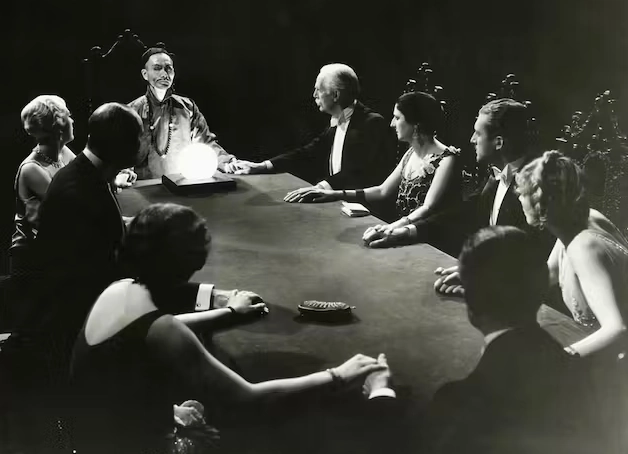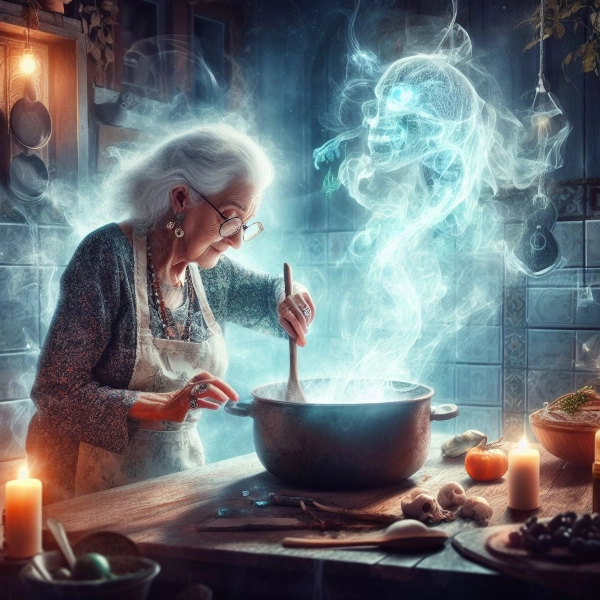Seances and Mediumship
Welcome to Channelin' Granny's Occult Haven, where the mystical arts of seances, spirit channeling, and mediumship transcend the ordinary. Just as a well-loved recipe passes through generations, we invite you to join us on a journey through time, uncovering the secrets of the spirit world. Here, within the walls of our haven, the veil between the living and the realm of spirits is delicately lifted. Explore the mesmerizing history and diverse methodologies of spirit connection as we delve into the pursuit of understanding the authenticity and significance of communing with the otherworldly. We aim to uncover the timeless wisdom and insights that lie beyond the confines of our everyday existence. Welcome to a place where the artistry of spirit communication intertwines with the comforts of home, creating an experience that nourishes both the soul and the senses.

The History of Seances
Seances, gatherings where individuals attempt to communicate with the spirits of the deceased, have a fascinating history dating back centuries. From the Victorian era's spiritualist movements to the modern-day paranormal investigations, the practice has evolved, leaving an indelible mark on the mystical landscape.
Explore the origins of seances and how they became a popular means of seeking messages from beyond the veil. Learn about notable figures who played a crucial role in popularizing seances and shaping the narrative of spirit communication.
Mediums around the World
Mediumship, the practice of communicating with the spirit world through intermediaries known as mediums, has woven its ethereal threads through the fabric of diverse cultures and epochs, showcasing the universality of humanity's fascination with the supernatural.
In ancient civilizations, the role of the medium was often intertwined with religious and shamanic practices. In ancient Greece, the Oracle of Delphi was a revered medium who channeled the wisdom of the god Apollo. The Oracle's cryptic prophecies influenced political and military decisions, showcasing the perceived connection between the divine and the mortal through a chosen intermediary.
Similarly, in ancient China, shamans acted as mediums, facilitating communication with ancestors and spirits. The Chinese tradition of Wuism involved spirit mediums known as Wu, who entered trance states to channel deities and provide guidance on matters ranging from health to agriculture. This practice reflected a belief in the ongoing connection between the living and the deceased within the fabric of daily life.
The indigenous cultures of the Americas, various tribes had their own traditions of mediumship. Native American tribes, such as the Navajo, engaged in ceremonies where spiritual leaders, or medicine men, acted as mediums to commune with the spirit world for healing and guidance. The intricate rituals underscored the interconnectedness of the physical and spiritual realms in these cultures.
In the context of African spirituality, the Yoruba people had the institution of the Babalawo, a priest and medium who communicated with Orishas, deities in the Yoruba pantheon. The Babalawo played a vital role in divination, offering insights and solutions to individuals seeking guidance or resolution to life's challenges.
The diverse expressions of mediumship across cultures underscore the human quest for connection with the divine, ancestors, and unseen forces. While the specific practices and beliefs surrounding mediums may vary, the underlying thread remains—a profound desire to bridge the gap between the tangible and the transcendent, seeking guidance, healing, and understanding from realms beyond the scope of everyday perception.
In Western Culture
In the dimly lit parlors of the Victorian era, a mysterious phenomenon emerged that would captivate the imaginations of individuals seeking a connection with the afterlife—the séance. The history of séances is a captivating journey through time, encompassing spiritual movements, influential figures, and the evolution of practices aimed at communicating with the spirits of the departed.
The roots of séances can be traced back to the mid-19th century, a time marked by a fervent interest in spiritualism. This movement gained momentum as people sought solace in the face of loss, and mediums claimed the ability to bridge the gap between the living and the dead. Séances, from the French word for "session," became the chosen method for these spiritual explorations.
Spiritualism found its most prominent stage in the 1840s and 1850s, with the Fox sisters of Hydesville, New York, claiming to communicate with a spirit through a series of mysterious rappings. This sparked widespread fascination and paved the way for the proliferation of séances as a means of spiritual communion. As the movement spread across Europe and North America, séances became fashionable social events, hosted in the parlors of the elite and attended by those eager to witness or partake in the mystical conversations with the beyond.
During this period, mediums played a central role in séances, acting as intermediaries between the living and the spirit realm. Notable figures like Madame Helena Blavatsky, a co-founder of the Theosophical Society, and Allan Kardec, a French educator who codified the principles of Spiritism, contributed to the shaping of séance practices. These spiritual leaders further popularized the idea that communication with spirits could provide insights into the mysteries of life and death.
The séance experience often involved a group of individuals seated around a table, holding hands, and focusing their collective energy to invite spirits to manifest. Mediums would enter trances, allowing spirits to communicate through them, conveying messages or producing physical phenomena like table rappings, levitation, or materializations. Séances became both a source of comfort for those grieving and a form of entertainment for the curious.
Over time, the spiritualist movement diversified, embracing various techniques and evolving into distinct branches of occult practices. Séances, however, endured as a symbol of the human quest to transcend the boundaries between the seen and the unseen. Today, séances continue to be explored in paranormal investigations, and the echoes of their historical significance persist in the enduring fascination with spirit communication—a testament to the enduring legacy of a bygone era where the veil between worlds seemed tantalizingly thin.

How to Conduct a Seance
Conducting a seance is an intricate process, akin to orchestrating an elaborate culinary experience. It involves weaving together an environment of spiritual connectivity much like the way a chef blends flavors to create a harmonious dish. Here's a detailed guide on how to conduct a seance, drawing parallels to the art of cooking:
- Setting the Stage: Similar to preparing a kitchen before cooking, create the right ambiance for the seance. Dim the lights, arrange comfortable seating in a circular formation, and infuse the space with calming elements like candles or incense.
- Curating Participants: Choose participants thoughtfully. Each individual contributes a unique energy to the seance circle, so it's essential to invite those who approach the experience with reverence and an open-minded attitude.
- Preliminary Preparation: Begin by guiding participants through relaxation techniques and meditation, aligning their energies and fostering a receptive state of mind.
- Commencing the Ritual: Initiate the seance with an opening ritual. This may involve setting intentions, invoking protective energies, and respectfully inviting spirits to join the gathering.
- Establishing Contact: The medium leading the seance must establish a connection with the spirit world. This could involve various methods such as using a Ouija board, pendulum, automatic writing, or intuitive channeling to communicate with the spirits.
- Maintaining Reverence: Ensure a respectful atmosphere during the interaction with spirits. Encourage open communication while upholding boundaries and etiquette to honor the spirits' presence.
- Concluding the Session: Conclude the seance with a closing ritual. Express gratitude to the spirits for their participation, bid them farewell respectfully, and guide participants in grounding their energies.
- Post-Seance Reflection: Encourage participants to reflect on their encounters. Allow time for sharing feelings, discussing messages received, and integrating any insights gained from the spiritual interaction.
Conducting a seance is a practice that demands meticulous attention, empathy, and a profound reverence for the spiritual world. Much like the dedication required to perfect a cherished homestyle recipe, mastering the art of leading a seance involves a blend of practice, patience, and an authentic connection to energies that transcend our physical realm. It's an ongoing journey that demands not only skill but also a deep understanding of the delicate interplay between the seen and the unseen, where intuition meets experience, and respect guides every interaction.
Who Can Commune with the Dead?
Communing with the deceased often involves individuals known as mediums, who bridge the gap between the living and the spirit world. Becoming a proficient medium is a journey that encompasses various paths of training and experiences.
Some individuals possess an inherent sensitivity to energies beyond the physical realm. They may exhibit heightened intuitive abilities or have experiences of perceiving spirit presences from a young age.
Engaging in development circles or groups dedicated to enhancing spiritual connections can aid in honing mediumistic abilities. These circles often provide mentorship, practice sessions, and guidance from experienced mediums.
Practices such as meditation and energy work play a vital role in refining spiritual awareness. These techniques help align energies, creating an environment conducive to connecting with the spirit realm.
Studying spiritual traditions, psychic phenomena, and mediumship techniques through books, workshops, or courses can expand knowledge and provide valuable insights into connecting with spirits.
Developing personal attributes such as patience, empathy, and an open mind is crucial. Mediumship requires a compassionate approach, deep listening skills, and a willingness to serve as a conduit between worlds.
Practical experience and mentorship from seasoned practitioners contribute significantly to mediumistic growth. Learning from experienced mediums, receiving feedback, and continually refining one's practice through real-life interactions are invaluable in the development of mediumship abilities. With the right attitude and proper training, anyone can commune with the dead!